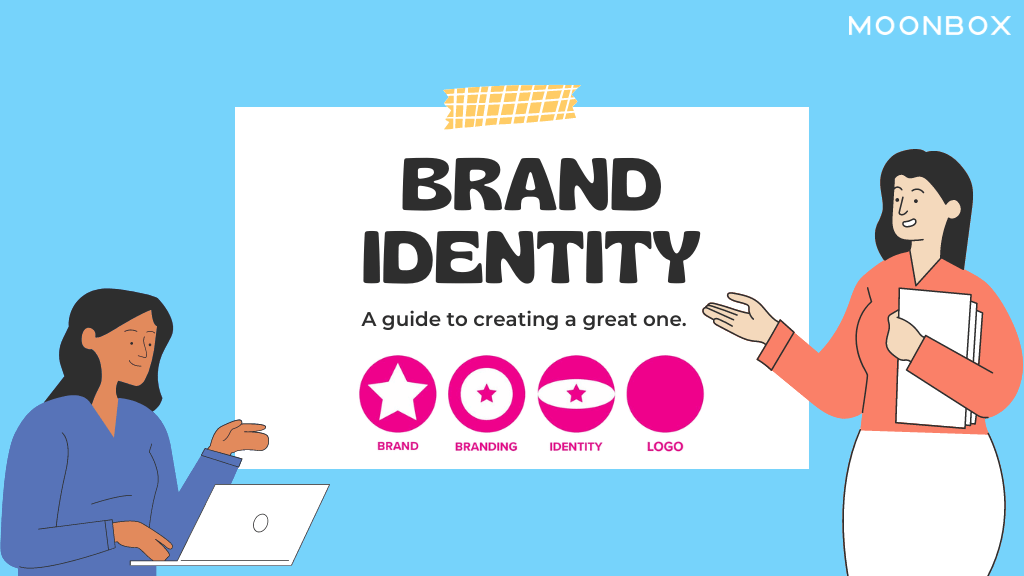Sep 26, 2022

Just like your identity makes you uniquely you, your brand identity is the unique sauce for your business that sets you apart from every other. And your brand identity design? It’s what shapes your company.
But what precisely is brand identity? How does it relate to design? And how do you shape a powerful brand identity that takes your business to the presiding level?
Brand identity is the pack of all elements that a company makes to illustrate the right image to its consumer. Brand identity is distinguishable from “brand image” and “branding,” even though these terms are sometimes treated as synonymous.
The term branding guides the marketing practice of actively shaping a unique brand. The brand represents how the world perceives the company.
Here are their five steps for creating a strong brand identity:
Step 1: Execute a Thorough Brand Audit
The first step is to determine where you stand in the marketplace and to comprehend who your client is. To do so, a company leader must realize what is essential for guiding growth and explore how the product or service is considered by consumers. Besides, an in-depth competitor analysis—including a review of competitor websites, search engine optimization, brand identities and advertising—tells who they will compete with for market share, how to determine, and what techniques to employ.
Step 2: Establish Your Unique Value Proposition
For a branding effort to be successful, a company must first determine its core philosophies, such as its mission statement and values. It’s also essential to distinguish your brand’s value proposition from the consumer. This is the basis of building a brand that truly symbolizes your organization.
Step 3: Develop Your Brand’s Creative Elements
The subsequent step is to complete the look, feel, and voice of the brand that will be taken through all marketing channels—from the website, to social media, advertisements, and packaging. The brand voice should be unique, resonate with your customers, be constant and stay true to your company’s values.
One way to guarantee that you are making the proper voice for your target audience is to consider their profession, social preferences, age, gender, and who else is marketing to them.
Step 4: Execute Strategies to Establish the Brand Identity
A brand identity is made over time. You must execute several strategies to assist grow brand awareness and strengthen the brand. It makes a robust social media presence using all the right channels to communicate instantly with the preferred target audience whether on Facebook, LinkedIn, Pinterest, Twitter, YouTube, or Instagram. The agency makes a PR strategy that delivers placements in the proper channels, such as trade journals, mass consumer publications, and television and print interviews. It creates a content marketing strategy that describes the story the company wants to be communicated to its target audience.
Make sure your company’s website and online reputation match the brand’s objectives. Also, assure your websites are mobile and search-friendly, load quickly, and include multiple contact points to touch with clients.
Step 5: Examine and Refine the Brand Identity
While a brand must establish an intrinsic value to the consumer, it does not mean it shouldn’t change over a period. To stay competitive, companies must regularly analyze and refine their brand to ensure it’s delivering on the promises of what the company stands for.
Visit and re-visit the above-mentioned five steps to frequently ensure that your business is an exact reflection of you.
Once you’ve gathered the building blocks of your design, it’s time to work with a designer to bring your brand identity to life and translate who you are as a brand into tangible design assets you can utilize in your marketing.
Your brand identity can be defined in any number of elements. Relying on the nature of your business, one asset or another may be more or less significant.
For example, a restaurant should put a lot of thinking into its menu and physical space. A digital marketing agency, however, needs to concentrate more on its website and social media pages.
Your logo creation is the cornerstone of your brand identity. When you are working with your designer, you want to choose your logo to tick off the subsequent boxes:
You also want to make sure that your design partner provides your logo in numerous formats (like a black and white version or multiple sizes) to guarantee you always have the logo you require—and that each is in line with your brand identity.
Learn more on How impactful is logo design on brand recognition?
Your website is one of the most suggestive aspects of your brand identity. Particularly if you’re running an online business or a digital product, your customers will review your website before determining to do business with you. Your website is where your brand identity should reach through in full force.
Colors are assertive and can communicate your brand personality from the first glimpse. When choosing your brand colors, consider how they reflect your identity and communicate to your target audience.
Here are the diverse types of brand colors you’ll need to determine:
When creating assets for your website or social media feed, customize your designs by picking from your core colors.
Just like many brands have excessively memorable colors, there are signature brand fonts, too — like Chobani. After their launch, fonts like this appeared to show up everyplace, from wedding invitations to startup brands to books to website headings.
If your product is a physical one, then product packaging is key to enticing the right customers. Whether you’re thinking the bottle of a cold-brew beverage or the mail you’ll send to your customers who purchased clothes from your eCommerce business, don’t underestimate the value of good design in enhancing the experience – and pushing both loyalty and repeat purchases. Packaging is an excellent opportunity for your design to shine.
Your brand identity is what sets you apart from the eternal sea of competitors and delivers your customers who you are and what they can expect from functioning with you. In today’s digital marketplace, your competition is no longer just the store across the street. Online you’ve got tens, hundreds, or even thousands of businesses just like yours competing for the spotlight.
A strong brand identity is more important than ever for small businesses to stand out. For small businesses to be successful, you must know who you are, what you offer, and to whom you’re offering your product or service.
Your brand lives in the souls of your customers. Provide extraordinary experiences.
